Amaurosis - Study guides, Class notes & Summaries
Looking for the best study guides, study notes and summaries about Amaurosis? On this page you'll find 231 study documents about Amaurosis.
Page 3 out of 231 results
Sort by
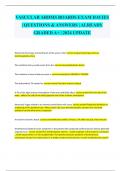
-
VASCULAR ARDMS BOARDS DAVIES EXAM | QUESTIONS & ANSWERS | ALREADY GRADED A+ | 2024 UPDATE
- Exam (elaborations) • 60 pages • 2023
-
- $11.09
- + learn more
VASCULAR ARDMS BOARDS DAVIES EXAM | QUESTIONS & ANSWERS | ALREADY GRADED A+ | 2024 UPDATE What's the first major arterial branch of the aorta is the? - Correct answer-Innominate artery or brachiocephalic artery The vertebral artery usually arises from the: - Correct answer-Subclavian Artery The incidence of new strokes per year is: - Correct answer-from 500,000 to 700,000 The abbreviation TIA stands for: - Correct answer-Transient Ischemic Attack A TIA of the right anterior hemisphere ...
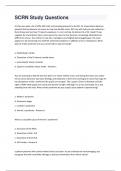
-
SCRN Study Questions Graded A+
- Exam (elaborations) • 18 pages • 2024
- Available in package deal
-
- $7.99
- + learn more
A 67yo man with a hx of HTN, DM, HLD, and smoking presents to the ED. CC of persistent dizziness q1week that has become so severe he now has double vision, N/V. His wife tells you she noticed a L facial droop and slurring. Pt reports weakness in L arm and leg. He denies HA or SZ. Head CT was negative for acute bleed. Upon returning to the room he has become increasingly obtunded and difficult to arouse. You notice he now has a nystagmus and slightly dysconjugate gaze. His exam appears to be...
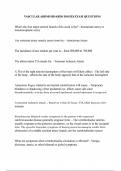
-
VASCULAR ARDMS BOARDS DAVIES EXAM QUESTIONS
- Exam (elaborations) • 72 pages • 2024
-
Available in package deal
-
- $12.00
- + learn more
What's the first major arterial branch of the aorta is the? - Innominate artery or brachiocephalic artery The vertebral artery usually arises from the: - Subclavian Artery The incidence of new strokes per year is: - from 500,000 to 700,000 The abbreviation TIA stands for: - Transient Ischemic Attack A TIA of the right anterior hemisphere of the brain will likely affect: - The left side of the body - affects the side of the body opposite that of the ischemic hemisphere Amaurosis Fugax relat...
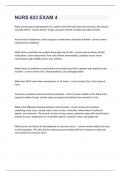
-
NURS 623 Exam 4 (2022/2023) test-bank complete solutions
- Exam (elaborations) • 7 pages • 2023
-
Available in package deal
-
- $14.99
- 1x sold
- + learn more
What are the typical demographics of a patient with MS (what type of person does this disease normally effect) - correct answer Young, caucasion female of eastern European desent At the onset of alzheimers, what category of medications should be initiated - correct answer Cholinesterase inhibitors What factors contribute to a patient being high risk for falls - correct answer History of falls, medications, vision impairment, heat rate/rhythm abnormalities, footwear issues, home environment...
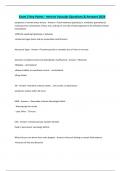
-
Exam 2 Key Points - Intro to Vascular Questions & Answers 2024
- Exam (elaborations) • 13 pages • 2024
-
- $13.99
- + learn more
Exam 2 Key Points - Intro to Vascular Questions & Answers 2024 symptoms of carotid artery lesions - Answer->-Focal weakness (paralysis) or numbness (paresthesia) involving some combination of face, arm, and leg on one side of body (opposite to the affected cerebral hemisphere) -Difficulty speaking (dysphasia or aphasia) -Amaurosis fugax (same side as responsible carotid lesion) Amaurosis fugax - Answer->Transient partial or complete loss of vision in one eye posterior circulation ...
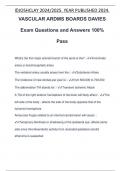
-
VASCULAR ARDMS BOARDS DAVIES Exam Questions and Answers 100% Pass
- Exam (elaborations) • 92 pages • 2024
- Available in package deal
-
- $11.49
- + learn more
VASCULAR ARDMS BOARDS DAVIES Exam Questions and Answers 100% Pass What's the first major arterial branch of the aorta is the? - Innominate artery or brachiocephalic artery The vertebral artery usually arises from the: - Subclavian Artery The incidence of new strokes per year is: - from 500,000 to 700,000 The abbreviation TIA stands for: - Transient Ischemic Attack A TIA of the right anterior hemisphere of the brain will likely affect: - The left side of the body - affects the side of...
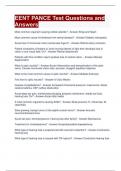
-
EENT PANCE Test Questions and Answers
- Exam (elaborations) • 5 pages • 2024
-
Available in package deal
-
- $13.39
- + learn more
EENT PANCE Test Questions and Answers Most common organism causing orbital cellulitis? - Answer-Strep and Staph Most common cause of blindness from retinal disease? - Answer-Diabetic retinopathy Acute loss of monocular vision (amaurosis fugax)? - Answer-Retinal artery occlusion Patient complains of floaters or small moving flashes of light then develops loss of vision in one visual field. Dx? - Answer-Retinal detachment Patients with this condition report gradual loss of central vi...
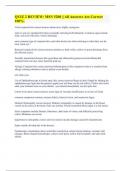
-
QUIZ 2 REVIEW: MSN 5200 || All Answers Are Correct 100%.
- Exam (elaborations) • 8 pages • 2024
-
- $10.79
- + learn more
Viral conjunctivitis correct answers adenovirus; highly contagious starts in one eye (unilateral) before eventually infecting both (bilateral). Common signs include itchy, red eyes with clear, watery discharge. most common type of conjunctivitis, and what doctors are often referring to when they use the term "pink eye." Bacterial conjunctivitis correct answers produces a thick white, yellow or green discharge from the affected eye(s). Sexually transmitted diseases like gonorrhea a...
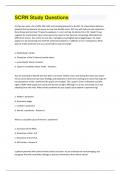
-
SCRN Study Questions Graded A+
- Exam (elaborations) • 18 pages • 2024
- Available in package deal
-
- $6.19
- + learn more
A 67yo man with a hx of HTN, DM, HLD, and smoking presents to the ED. CC of persistent dizziness q1week that has become so severe he now has double vision, N/V. His wife tells you she noticed a L facial droop and slurring. Pt reports weakness in L arm and leg. He denies HA or SZ. Head CT was negative for acute bleed. Upon returning to the room he has become increasingly obtunded and difficult to arouse. You notice he now has a nystagmus and slightly dysconjugate gaze. His exam appears to be...
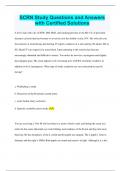
-
SCRN Study Questions and Answers with Certified Solutions
- Exam (elaborations) • 31 pages • 2023
- Available in package deal
-
- $10.99
- + learn more
SCRN Study Questions and Answers with Certified Solutions A 67yo man with a hx of HTN, DM, HLD, and smoking presents to the ED. CC of persistent dizziness q1week that has become so severe he now has double vision, N/V. His wife tells you she noticed a L facial droop and slurring. Pt reports weakness in L arm and leg. He denies HA or SZ. Head CT was negative for acute bleed. Upon returning to the room he has become increasingly obtunded and difficult to arouse. You notice he now has a nystagmus ...

How did he do that? By selling his study resources on Stuvia. Try it yourself! Discover all about earning on Stuvia


